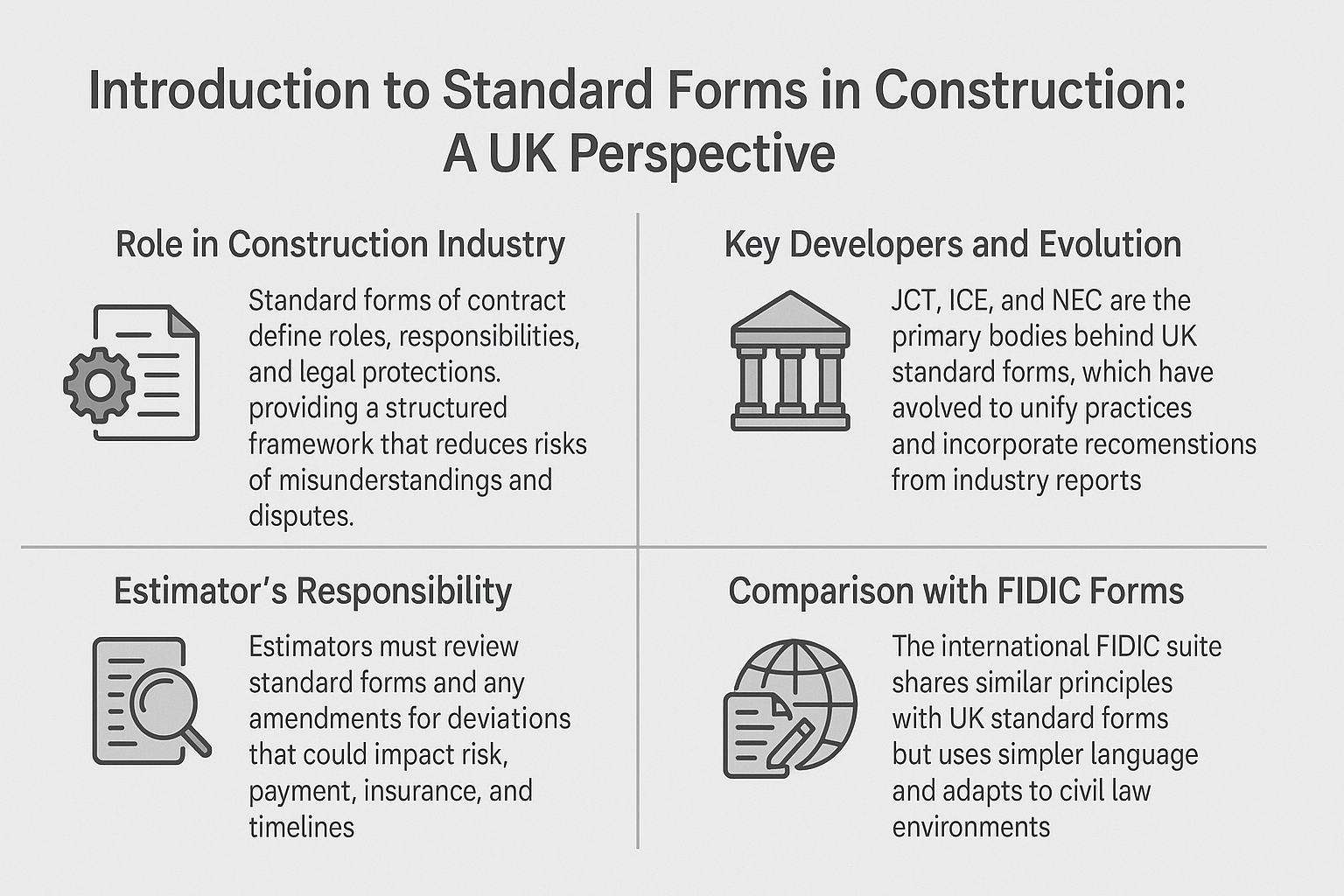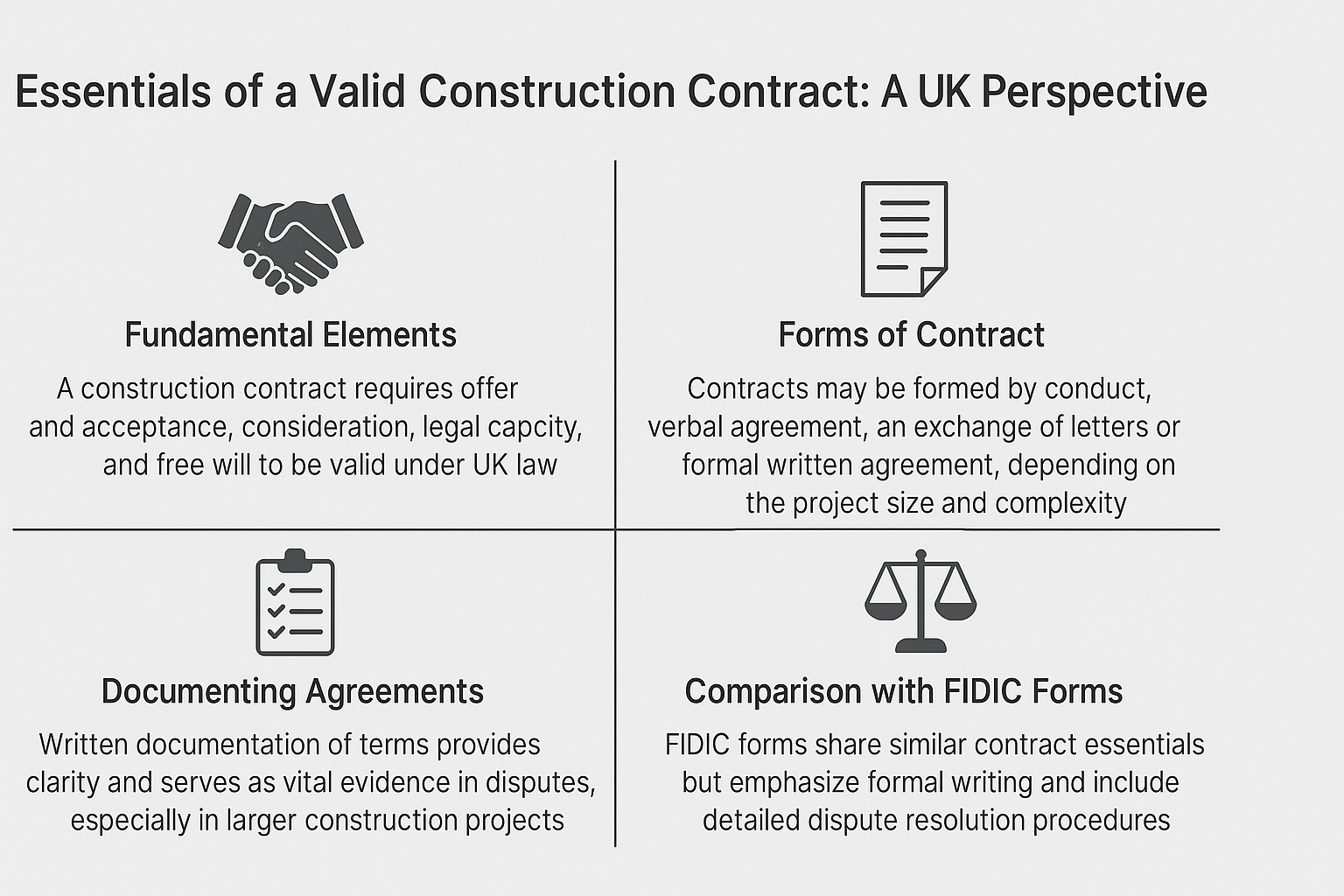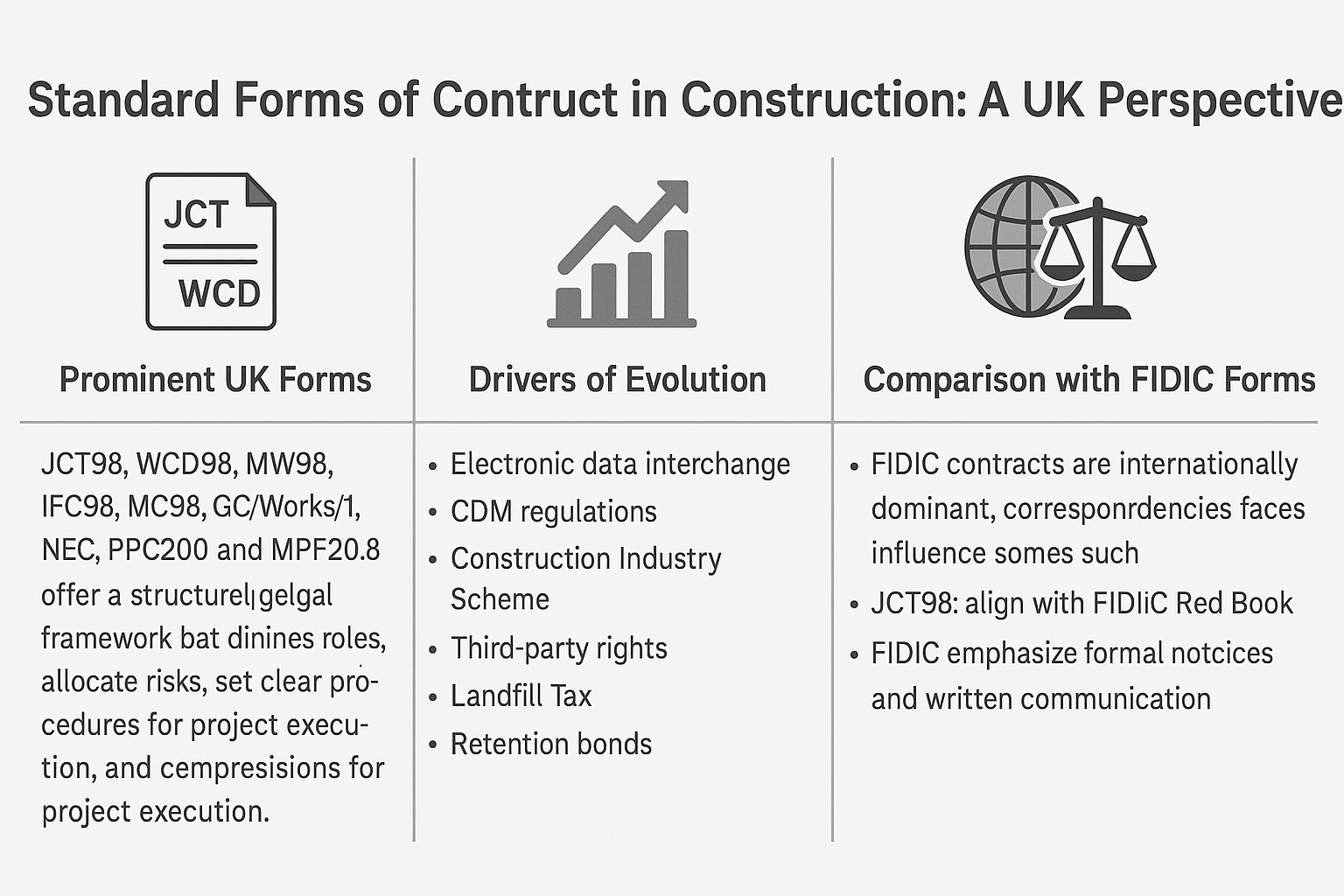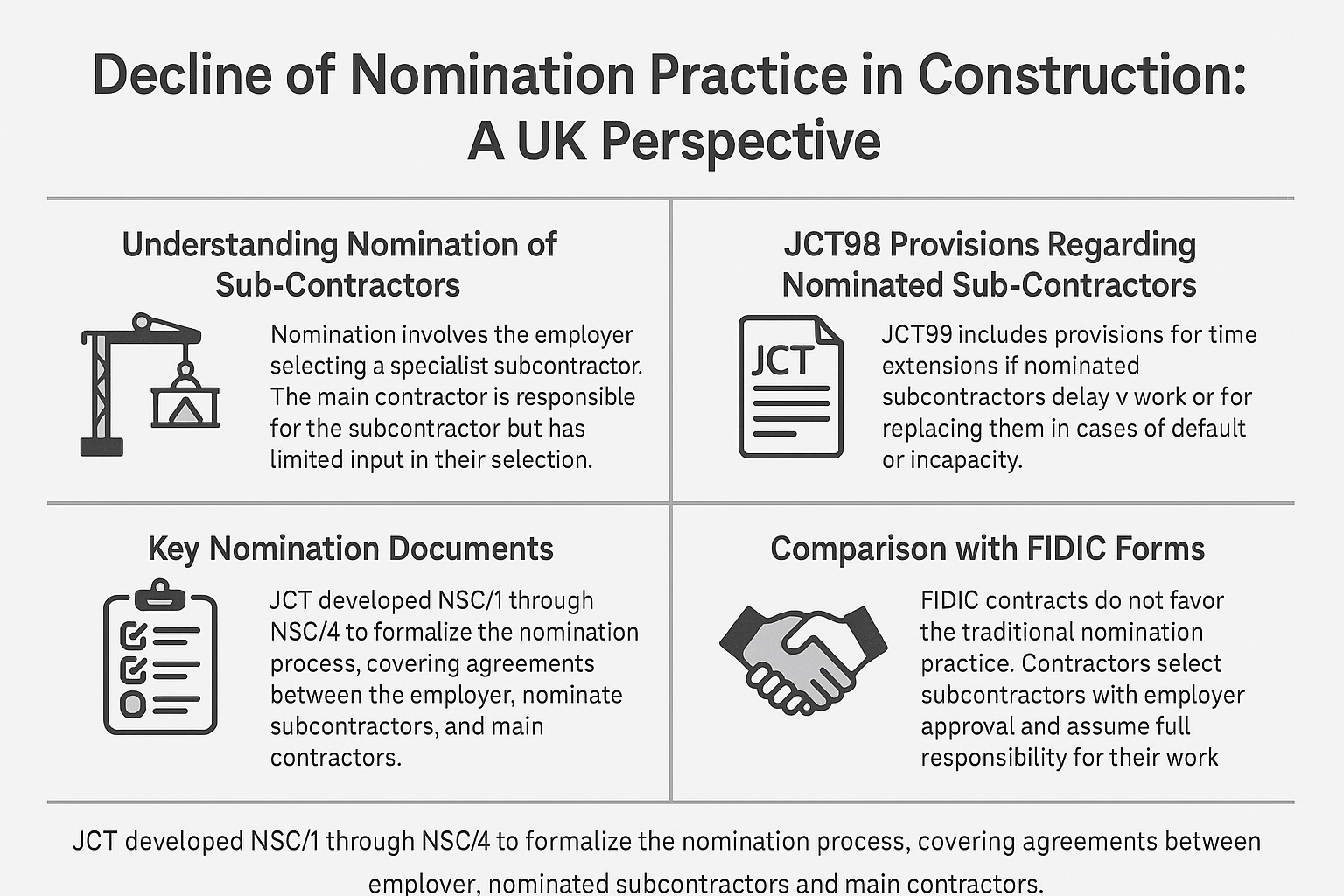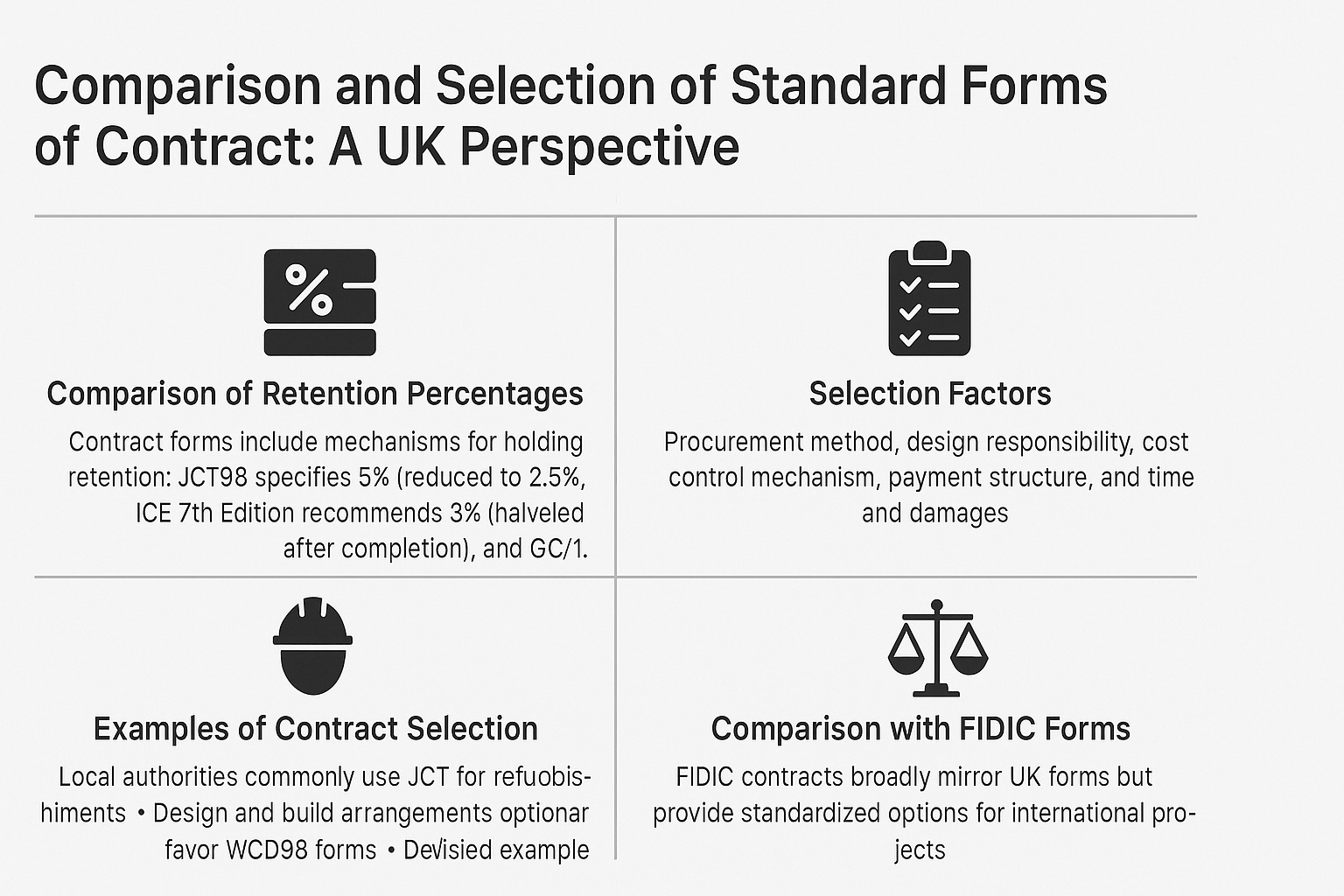Introduction to Standard Forms in Construction: A UK Perspective
In the construction industry, standard forms of contract serve as critical instruments that define the roles, responsibilities, and legal protections of the parties involved. They provide a structured framework that reduces the risks of misunderstanding and disputes, setting clear expectations for performance, timelines, payments, and risk allocation. In the United Kingdom, particularly under the legal system of England and Wales, standard forms have evolved over decades to reflect both legal principles and industry practices.
The most prominent bodies responsible for developing these standard forms in the UK are the Joint Contracts Tribunal (JCT), the Institution of Civil Engineers (ICE), and later, the New Engineering Contract (NEC) suite. Each organization addressed different sectors of the construction industry: JCT for building works, ICE for civil engineering projects, and NEC for a broader range of engineering and infrastructure developments with a modern approach to project management.
The evolution of standard forms has been significantly influenced by attempts to unify contractual practices across the industry. One major milestone was the Banwell Report of 1964, which identified inefficiencies in construction procurement and recommended the creation of a unified contract applicable across public and private sectors. Later, the Latham Report of 1994 reinforced this idea, emphasizing the need for collaboration, trust, and fairness between clients and contractors. Sir Michael Latham notably recommended widespread adoption of the New Engineering Contract (NEC) family, which was seen as a progressive move toward achieving a single standard. However, despite these initiatives, complete unification never materialized. Instead, a proliferation of standard forms continues today, each tailored to specific procurement methods, project types, and industry preferences.
For estimators, the existence of multiple standard forms presents both challenges and responsibilities. An estimator must carefully review the standard form proposed for a project, paying particular attention to amendments and details inserted into appendices. These details can significantly alter risk allocations, payment terms, insurance obligations, and timelines. If amendments impose onerous conditions, the estimator must advise management accordingly so that such risks can be priced into the tender or mitigated contractually. Neglecting this critical review could result in the contractor accepting hidden risks that impact profitability or operational delivery.
Importantly, estimators must not only assess the “standard” conditions but must also verify any deviations from the standard language. Non-standard modifications are common, and subtle changes can have substantial legal and financial implications. For instance, an increased retention percentage or altered termination rights can shift the commercial balance of a contract.
The use of standard forms thus provides a common language across the UK construction industry. Still, it demands expertise and vigilance to ensure that each project’s specific conditions are properly understood and accounted for.
Comparison with FIDIC Forms
When compared internationally, the FIDIC (Fédération Internationale Des Ingénieurs-Conseils) suite of contracts represents the global standard, particularly in large-scale infrastructure and cross-border projects. FIDIC contracts, like the Red Book (for employer-designed works), Yellow Book (for design and build), and Silver Book (for EPC/turnkey projects), mirror many principles found in UK standard forms but are adapted for international practices and civil law environments.
For example, the JCT Standard Form closely parallels the FIDIC Red Book as both are based on a traditional design-bid-build model where the employer designs and the contractor constructs. The JCT With Contractor’s Design (WCD98) corresponds with the FIDIC Yellow Book, where the contractor is responsible for both design and construction.
However, a major difference lies in language and style. UK forms like JCT and ICE are drafted in technical legal language, rooted firmly in English common law. FIDIC, meanwhile, uses simpler and more accessible English to cater to a global audience. Moreover, while JCT and ICE assume familiarity with UK legal principles (e.g., implied terms, detailed insurance clauses), FIDIC is more self-contained, ensuring it is understandable in jurisdictions without a strong common law tradition.
Additionally, the NEC suite, praised for its flexible and collaborative approach, shares a similar ethos with FIDIC’s newer editions but still reflects distinct UK-centric project management philosophies.
In conclusion, while the UK’s standard forms and FIDIC contracts serve parallel functions, they are crafted for different audiences and legal systems. Understanding these distinctions is vital for anyone involved in estimating, tendering, or managing international construction contracts.
Essentials of a Valid Construction Contract: A UK Perspective
In the construction industry, contracts form the backbone of any project, ensuring that roles, responsibilities, and expectations are clearly defined and legally enforceable. In the United Kingdom, particularly under the legal system of England and Wales, a construction contract must meet certain fundamental requirements to be considered valid and binding.
First and foremost, there must be offer and acceptance. An offer is a clear proposal made by one party to another, expressing a willingness to enter into a contract on specified terms. Acceptance, in turn, must be unequivocal and communicated clearly. In construction, the offer typically takes the form of a tender, bid, or quotation, while acceptance is usually a formal letter or the signing of a contract. Without a proper offer and acceptance, no binding agreement can be said to exist.
The second essential element is consideration. Consideration refers to something of value exchanged between the parties. In a construction contract, this usually involves the contractor agreeing to build or perform certain works in exchange for payment from the employer. Consideration must be sufficient but need not be adequate; it must represent a mutual exchange of value, forming the core of the parties’ obligations to one another.
Thirdly, there must be legal capacity. Each party entering the contract must have the legal ability to do so. This generally means being of sound mind, of legal age, and not being disqualified from contracting (for example, an undischarged bankrupt may face restrictions). Companies and corporations must act within their corporate powers and often require authorization from directors or legal representatives.
The fourth requirement is free will. A contract must be entered into voluntarily, without duress, undue influence, misrepresentation, or fraud. Parties must have genuine consent to be bound by the agreement. If free will is compromised, the contract may be voidable at the instance of the wronged party.
In addition to these fundamental elements, the way construction contracts are formed can vary significantly. They can be created by conduct (for example, a contractor starting work after being told they have won the tender), through a verbal agreement (common in small works), by an exchange of letters (where offers and acceptances are documented in correspondence), or through a formal written agreement.
Despite the flexibility in contract formation methods, the importance of documenting everything cannot be overstated. Particularly in larger or more complex projects, written contracts that clearly capture the terms, scope of work, payment structure, timelines, and risk allocation provide critical evidence if a dispute arises. Where negotiations occur after an initial offer, it is vital to retain records of all communications to accurately reflect the agreed terms.
Maintaining a well-organized file containing the tender documents, minutes of meetings, correspondence, and signed agreements is not just good practice—it can be the deciding factor in successfully enforcing contractual rights.
Comparison with FIDIC Forms
When viewed against the FIDIC (Fédération Internationale Des Ingénieurs-Conseils) forms, widely regarded as the international standard for construction contracts, the essentials of a valid construction contract remain largely consistent. The FIDIC Red Book, Yellow Book, and Silver Book also rely on clear offer and acceptance, consideration, legal capacity, and free will.
However, FIDIC contracts are designed for a global audience and thus incorporate mechanisms to make the contract self-sufficient and clear, even in jurisdictions where common law concepts may not be as deeply rooted. For example, FIDIC documents expressly define key terms like “Contractor”, “Employer”, and “Engineer” and lay down comprehensive procedures for acceptance, performance security, and variations.
Another difference lies in the reliance on formal writing. While English law accepts verbal agreements and contracts by conduct, FIDIC forms are structured around a formal written contract, with strict requirements for notices and communications. This emphasis on written documentation minimizes ambiguity and strengthens enforceability across different legal systems.
Moreover, FIDIC contracts typically provide detailed dispute resolution procedures, including amicable settlement periods, Dispute Adjudication Boards (DABs), and international arbitration frameworks. In contrast, many UK standard forms (such as JCT and NEC) incorporate local dispute resolution norms unless otherwise modified.
In summary, the essentials of a valid construction contract under the UK system closely mirror those in FIDIC forms, though FIDIC places a greater emphasis on formal documentation and internationally uniform procedures. Both systems highlight the critical importance of clear agreements, mutual exchange of value, legal capacity, voluntary participation, and proper recording of all contractual terms and amendments
Standard Forms of Contract in Construction: A UK Perspective
In the United Kingdom, particularly under the legal system of England and Wales, the construction industry relies heavily on standard forms of contract. These forms offer a structured legal framework that defines roles, allocates risks, and sets clear procedures for project execution, payments, and dispute resolution. Various standard forms cater to different types of projects, procurement methods, and complexity levels.
Prominent examples of UK standard forms include:
- JCT98 (Joint Contracts Tribunal Standard Form with or without quantities): A traditional design-bid-build contract for building projects where the client provides full designs. It creates a lump-sum contract, but the price is subject to adjustment through mechanisms like variations, extensions of time, and loss and expense claims.
- WCD98 (JCT Standard Form with Contractor’s Design): Similar to JCT98 but adapted for design and build projects where the contractor is responsible for the design as well as the construction.
- MW98 (Minor Works): A simplified version of the JCT contract for small projects, with a straightforward structure suitable for works that do not require complex risk allocation or contract administration.
- IFC98 (Intermediate Form of Building Contract): Designed for projects larger than those suitable for Minor Works but not complex enough for the full JCT Standard Form. It strikes a balance between simplicity and detailed provisions.
- MC98 (Management Contract): Suitable for management contracting arrangements where the contractor manages the construction works through a series of separate works contracts, rather than undertaking the building work themselves.
- GC/Works/1: Primarily used for government contracts, this form offers flexibility through various editions for major works, minor works, design and build, and mechanical and electrical projects.
- ICE 7th Edition (Institution of Civil Engineers Conditions): A standard form specifically developed for civil engineering projects. It follows a measure-and-value contract approach, where the quantities of work are remeasured as the project progresses. It also clearly distinguishes between permanent and temporary works, an important feature for civil projects.
- NEC (New Engineering Contract): A modern suite of contracts using simple language, emphasizing collaboration and flexible pricing mechanisms. NEC contracts can accommodate lump sum, target cost, cost reimbursable, and management contracting.
- PPC2000 (Project Partnering Contract): A contract designed to promote early collaboration between all parties in the construction supply chain, encouraging integrated project teams.
- MPF2003 (Major Project Form): Tailored for major projects that may involve complex procurement and need customized risk-sharing mechanisms.
The continuous evolution of these forms has been driven by industry changes and legal reforms, particularly after the Banwell Report (1964) and the Latham Report (1994). Key factors that influenced the newer editions include:
- Electronic Data Interchange (EDI): Integration of digital data exchange in project documentation.
- CDM Regulations: Enhanced health and safety obligations in construction design and management.
- Construction Industry Scheme (CIS): Tax regulations impacting payments to subcontractors.
- Third-party rights: Reforms allowing third parties to enforce contract terms under certain conditions.
- Landfill Tax: Introduction of environmental levies impacting construction waste disposal.
- Retention bonds: Alternative to cash retentions to secure performance and defects liability.
Comparison with FIDIC Forms
Internationally, the FIDIC (Fédération Internationale Des Ingénieurs-Conseils) suite of contracts is the predominant standard, especially for cross-border infrastructure and engineering projects.
- JCT98 corresponds closely to the FIDIC Red Book, where the employer designs and the contractor builds.
- WCD98 aligns with the FIDIC Yellow Book, where the contractor handles both design and construction.
- MC98 shares similarities with certain FIDIC project management structures but lacks a direct FIDIC equivalent; FIDIC tends to structure management responsibilities differently.
- ICE Conditions parallel the FIDIC Red Book with its focus on measurement and valuation, and clear demarcation of permanent versus temporary works.
- NEC Contracts offer a more collaborative and flexible alternative, somewhat similar to recent FIDIC revisions, such as the FIDIC 2017 suite, though NEC’s collaborative spirit is even stronger.
- PPC2000 has no true FIDIC equivalent; however, FIDIC is moving towards greater collaboration models through its newer contracts.
One key distinction is that FIDIC contracts are drafted for international use, balancing different legal systems (common law and civil law), and heavily emphasize formal notice procedures and written communication. UK contracts, particularly JCT and ICE forms, presuppose a common law environment and may be less self-contained for use in other jurisdictions without adaptation.
In summary, while the UK standard forms offer tailored solutions for local practice under English law, FIDIC provides a versatile, internationally recognized framework, facilitating smoother execution of projects across diverse legal landscapes.
Sub-Contract Forms in Construction: A UK Perspective
In construction projects under the UK legal system (England and Wales), subcontracting is a vital mechanism for delivering specialized work packages efficiently. Sub-contract forms establish the contractual relationships between main contractors and their specialist trade contractors, helping to manage project complexity and risk allocation. Different types of subcontractors and standard forms of subcontracts are used, each tailored to different procurement scenarios and project needs.
Types of Sub-Contractors
- Nominated Sub-Contractors: Selected by the client (often through the architect or engineer) and imposed on the main contractor. These subcontractors are usually chosen for their specialist skills or preferred products. While the contractor is responsible for their performance contractually, the choice lies with the employer.
- Domestic Sub-Contractors: Chosen by the main contractor, often with the architect’s consent under contracts like JCT98. These are typical trade specialists hired to carry out portions of the work.
- Named Sub-Contractors: Selected from a pre-agreed shortlist provided by the employer or architect, but the contractor holds the ultimate contractual relationship. This method blends employer input with contractor autonomy.
Standard Sub-Contract Forms
Several standard sub-contract forms have been developed in the UK to govern these relationships:
- DSC/C (Domestic Sub-Contract Conditions): Used alongside JCT98 for general subcontracting under standard terms, often amended by main contractors.
- DOM/2: Tailored for subcontracting under contractor-designed projects (WCD98), adapting responsibilities for design and workmanship.
- CECA Form: Designed for civil engineering subcontracting under ICE Conditions, sometimes referred to as the “Blue Form.”
- NAM/SC: For named subcontractors under IFC98, providing clear guidance when subcontractors are pre-selected but engaged contractually by the contractor.
- IN/SC: A domestic subcontract form aligned with IFC98 for intermediate-size projects.
- GW/S: Subcontract form linked to GC/Works/1 contracts, aligning with public sector construction works.
- NEC Subcontract: A modular, flexible subcontract form aligned with NEC principles, encouraging collaboration and clear risk management.
These standard forms help ensure that subcontracting relationships mirror the risk and responsibility allocations found in the main contract, providing consistency and minimizing legal uncertainties.
Problems Faced by Sub-Contractors
Despite the structured nature of standard forms, subcontractors historically have faced several common problems:
- “Pay When Paid” Clauses: These clauses allowed main contractors to delay payment to subcontractors until they themselves were paid. Such practices were severely curtailed by the Housing Grants, Construction and Regeneration Act 1996, ensuring subcontractors have more reliable payment terms.
- Delayed Payment Discounts: Main contractors sometimes withheld early payment discounts even after the agreed payment period passed, creating cash flow issues for subcontractors.
- Unfair Burdens: Main contractors occasionally passed on obligations like scaffolding, hoisting, and rubbish disposal to subcontractors without adequate compensation or resources.
- Limited Rights for Time Extensions: Subcontractors sometimes faced difficulties securing extensions of time, particularly where main contractors delayed passing through information or approvals.
- Broad Rights for Deductions: Main contractors often reserved sweeping rights to make deductions from payments for alleged defects, delays, or claims without necessarily substantiating losses.
- Risky “On Demand” Bonds: Subcontractors were sometimes required to provide performance bonds that could be called without proof of default, putting small firms at severe financial risk.
To mitigate these risks, subcontractors must carefully review subcontract terms, negotiate fairer terms where possible, and ensure compliance with the relevant legal protections.
Comparison with FIDIC Forms
In the international arena, FIDIC contracts provide a comprehensive structure for subcontracting, although they do not publish separate standard subcontract forms for each main contract. Instead, the FIDIC Red Book (Construction Contract) and FIDIC Yellow Book (Design and Build Contract) outline clear procedures for subcontracting.
- Under FIDIC, subcontractors must typically be approved by the engineer or employer, and the main contractor remains fully responsible for subcontractors’ work.
- FIDIC does not promote “pay when paid” clauses; payments to subcontractors are generally expected to be managed responsibly.
- Subcontractors’ rights and obligations are derived from the main contract’s framework, ensuring consistency.
- The recent FIDIC 2017 editions offer more detailed risk allocation, aiming to balance the interests of all project participants, including subcontractors indirectly.
Overall, while UK standard subcontract forms offer comprehensive protection when properly used, subcontractors globally, under both UK forms and FIDIC frameworks, must remain vigilant to protect their rights and ensure their responsibilities are clearly defined and manageable.
Decline of Nomination Practice in Construction: A UK Perspective
In the UK construction industry, particularly under the legal system of England and Wales, the practice of nominating sub-contractors has historically played a significant role. However, over recent years, nomination has seen a significant decline, influenced by changes in procurement methods, contractual risk management, and legal reforms.
Understanding Nomination of Sub-Contractors
Nomination involves the employer (or their agent, typically the architect) selecting a specialist subcontractor to carry out a specific portion of the work. The main contractor, while contractually responsible for the subcontractor’s performance, has limited input into their selection.
While this method allowed employers to secure favored specialists or specific systems, it introduced substantial risks for main contractors, who had to bear responsibility for subcontractors they did not choose. Consequently, the industry has moved away from nomination in favor of direct engagement strategies that better align responsibility with control.
JCT98 Provisions Regarding Nominated Sub-Contractors
The JCT98 Standard Form of Building Contract contains detailed provisions addressing the use of nominated sub-contractors. Key aspects include:
- Delay by a Nominated Sub-Contractor: If a nominated sub-contractor delays their work, it is recognized as a “relevant event” under Clause 25, entitling the main contractor to apply for an extension of time. This mechanism helps shield the main contractor from liquidated damages arising solely from a subcontractor’s delay.
- Replacement of a Nominated Sub-Contractor: If a nominated subcontractor becomes incapable of performing their obligations due to insolvency, breach, or other failures, the architect must nominate a replacement. This provision ensures project continuity and provides a remedial pathway when nominated subcontractors default.
Despite these protective clauses, main contractors often felt exposed to risks beyond their control, particularly relating to coordination difficulties, design issues, and performance disputes, which contributed to the declining preference for nomination.
Key Nomination Documents
JCT developed specific documentation to formalize and manage the nomination process, including:
- NSC/1 (Tender and Agreement): Used to invite tenders from potential nominated sub-contractors, setting out tendering procedures and the basis for eventual contractual terms.
- NSC/2 (Employer-Nominated Sub-Contractor Agreement): Establishes direct contractual obligations between the employer and the nominated subcontractor, especially regarding design responsibility and workmanship warranties.
- NSC/3 (Instruction to Enter Sub-Contract): Formalizes the instruction from the architect for the main contractor to enter into a sub-contract with the nominated subcontractor.
- NSC/4 (Sub-Contract Conditions): Provides the detailed terms and conditions governing the relationship between the main contractor and the nominated subcontractor, incorporating back-to-back obligations mirroring the main contract.
These documents were carefully structured to maintain clarity in roles and responsibilities, although practical challenges persisted.
Why the Practice Declined
Several factors contributed to the move away from nomination:
- Greater focus on risk management and ensuring that responsibility aligns with selection and control.
- Legal challenges concerning liability apportionment when nominated subcontractors failed to perform.
- Emergence of design and build contracts, where main contractors prefer full control over all subcontracting arrangements.
- Market evolution towards integrated project teams and partnering approaches.
Today, nomination is rare in standard UK construction procurement, reserved only for special circumstances requiring highly specialized inputs.
Comparison with FIDIC Forms
In contrast, FIDIC contracts (Fédération Internationale Des Ingénieurs-Conseils) take a different approach to subcontracting. Under the FIDIC Red Book and FIDIC Yellow Book, the employer does not directly nominate subcontractors. Instead:
- Contractors are generally free to select their own subcontractors, subject to approval by the Engineer or Employer.
- The contractor remains fully responsible for the acts and omissions of subcontractors, avoiding the fragmented responsibility that can arise in traditional nomination.
- FIDIC emphasizes clear procedures for subcontractor approval and assigns all coordination responsibilities to the main contractor.
Thus, FIDIC’s structure naturally discourages the nomination system as understood in traditional UK practice, promoting a more coherent and unified risk structure.
Conclusion
The decline of nomination under UK standard forms, such as JCT98, reflects a broader industry trend toward improved risk management and clearer contractual relationships. While FIDIC contracts have always minimized nomination practices, the UK market has evolved to mirror similar principles, favoring contractor-led selection with employer oversight rather than direct employer-imposed nominations.
Comparison and Selection of Standard Forms of Contract: A UK Perspective
In the construction industry within the UK legal system (England and Wales), selecting the appropriate standard form of contract is critical to a project’s success. Standard forms differ significantly in structure, content, risk allocation, payment mechanisms, and insurance requirements. Understanding these distinctions helps contractors, consultants, and clients choose a contract that aligns with their project’s needs and risk appetite.
Comparison of Contract Document Sets and Retention Percentages
Different standard forms incorporate varying requirements for documentation and financial management, notably through the use of retention percentages. Retention is a portion of payments withheld to ensure performance and remedy defects.
- JCT98 (Joint Contracts Tribunal): A 5% retention is held until practical completion, after which it reduces to 2.5%. This provides a financial incentive for contractors to address defects promptly while ensuring that clients have security against incomplete or defective works.
- ICE 7th Edition (Institution of Civil Engineers Conditions): Recommends a 3% retention, which is halved following the issuance of a certificate of completion. The ICE form’s more moderate approach reflects the typically high degree of trust and technical oversight in civil engineering projects.
- GC/Works/1 (Government Contracts): Retention mechanisms are also incorporated but are tailored depending on the type of project, whether major works, minor works, or design and build.
Each form also addresses insurance requirements, ensuring that risks associated with loss, damage, injury, and third-party claims are properly covered. Notably, the ICE form uniquely recommends the use of a bond format, providing additional financial security beyond standard insurance policies. Bonds offer clients protection against contractor default, especially critical in large-scale or high-risk projects.
Selection of Contract Forms: Key Factors
Choosing the right form of contract depends on several project-specific factors:
- Procurement Method: Whether the project is based on a lump sum, measurement and remeasurement, or cost reimbursement model. Lump sum methods favor contracts like JCT98, while remeasurement models are suited to ICE conditions.
- Design Responsibility: Projects where the client retains full design responsibility favor traditional forms like JCT98. In contrast, design and build arrangements, where the contractor handles both design and construction, favor forms such as WCD98 (JCT Standard Form with Contractor’s Design).
- Cost Control Mechanism: Bills of quantities, priced schedules of work, or contract sum analyses determine how cost control and valuation of variations are managed during the project.
- Payment Structure: Stage payments versus time-based payments affect cash flow management for both contractors and employers. For example, GC/Works/1 adopts structured interim payments based on milestones.
- Time and Damages Structure: Considerations include whether liquidated damages are applied for delay, and the flexibility for extensions of time under specified events.
Examples of Contract Selection
- Local Authorities often favor JCT Local Authority versions, particularly for refurbishment works or where public sector procurement rules apply.
- Design and Build Projects are increasingly favoring WCD98 forms, allowing a single point of responsibility and simplifying employer risk profiles.
A structured selection checklist helps ensure that the right contract form is chosen by aligning the procurement method, design obligations, financial control measures, and project-specific time considerations.
Comparison with FIDIC Forms
When compared internationally, the FIDIC suite of contracts reflects many similar principles but adapts them for cross-border, multi-jurisdictional use.
- Retention: FIDIC contracts typically allow employers to retain a portion of interim payments (usually 5%), similar to JCT, with reductions after taking over certificates. The approach is more standardized in FIDIC to suit international norms.
- Insurance and Bonds: FIDIC forms, particularly the Red Book and Yellow Book, impose detailed insurance requirements and often require performance security (bonds) and advance payment guarantees.
- Selection Based on Procurement Model: FIDIC offers specific books tailored to different procurement models — the Red Book for employer-designed projects, the Yellow Book for design and build, and the Silver Book for turnkey EPC projects.
- Design Responsibility: Like WCD98, the FIDIC Yellow Book assigns full design responsibility to the contractor, promoting a one-stop delivery approach.
Overall, while UK standard forms offer precise structures under English law for local use, FIDIC provides internationally harmonized templates adaptable across diverse legal environments. Understanding the nuances between these frameworks is crucial for making informed contract choices in domestic and international construction projects.


